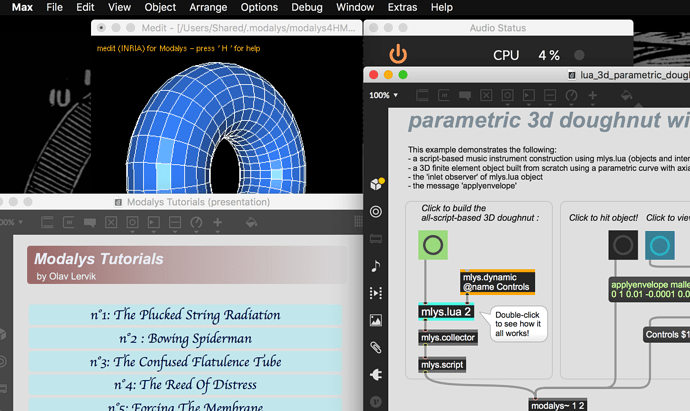Hi!
Ok, we are moving faster and faster towards the public release of Modalys 3.6.0…
Highlights of 3.6.0 beta 14:
- Improved overall stability
- Windows:
- up-to-date Modalys for Max externals
- medit.exe (new!)
- finite elements (new!)
- Max: New ‘extra’ menu item: “Modalys Tutorials” leading to Olav Lervik’s video tutorials. Takk H. Lervik!
- mlys.lua: getting very close to feature completion.
Thank you again for you testing, and do no hesitate if you have any comment or question!
Robert
cumulative notes for Modalys 3.6 beta
3.6.0.b8…b14:
- mac installer: automatic installation of modalys Max package (by scanning default locations)
- compatibility with macOS 10.15 Catalina and macOS 11 (Big Sur), including when running under “rosetta2” emulation on a new ARM mac machine.
- fully notarized installer
- recompiled, correctly codesigned Modalisp and Medit
- updated Matlab objects (64bit)
- fixed violin bridge object (long-standing issue…)
- Modalys for Max:
- Windows:
- a looong overdue: finite elements on Windows

- another looong overdue: medit.exe for 3D visualisation!
- externals have been entirely recompiled to reflect latest features and fixes
- a looong overdue: finite elements on Windows
- new Max ‘extra’: Modalys tutorials (thanks to Olav Lervik!)
- an old bug has been fixed that could explain some strange past behaviors…
- Windows:
- mlys.lua :
- new examples
- new Parametric2dCurve class for easy 3d object construction (see the lua_3d_parametric_object example)
- return value from (update() function) did nothing!
- the dimension parameter of a mlys.lua object is now automatic if “-1” is set (which is by default for new objects).
- mlys.get_info can now return strings (and, of course, numbers)
- bow and felt connections implemented
- moved from luajit to moonjit lib
- new function modalys.view_mesh(–mesh ref–): to invoke Medit
- new object modalys.inlet_observer to monitor inlet updates. With “modalys.inlet_observer.callback = my_callback” you shall assign a callback of your own receiving 2 parameters: inlet# and current float value.
3.6.0.b7:
Modalys for Max
- mlys.lua:
- “mlys” alias namespace created. So instead of “modalys.freq_to_midi”, you may write the more compliant “mlys.freq_to_midi”
- aliases added to functions, to match legacy namings: modalys <-> mlys, make_object <-> create_object,
make_connection <-> create_connection, make_mesh <-> create_mesh, make_point_output <-> create_point_output, extend_mesh <-> create_mesh
3.6.0.b6:
Modalys for Max
- a long-standing request: modifying an attribute in mlys.expression (and now mlys.lua) doesn’t erase the script content anymore!
- mlys.lua:
- improved stability.
- modalys.release now accepts any series of item references. For instance modalys.release(mystring,mymesh,ctrl1)
- new function modalys.compute_modes(–object reference–)
- new function get_pitched_finite_element_object(–parameters–). Parameters are: “mesh”, “name”, “block” (a mesh that describes the fixed nodes), “midinote” or “frequency”, “modes” (amount), “thickness” (for 2D mesh), “density”, “young”, “poisson”, “constloss”, “freqloss”.
- new function modalys.freeze_object(–object reference–) For now, it is only for actual objects (strings, tubes etc.) but the plan is to extend it to access and controllers.
- new function modalys.get_mesh(–object reference–) to get the mesh reference of a given 3D-based object.
- new objects implemented in create_object (more to come…)
- new connections implemented in create_connection (more to come…)
3.6.0.b4:
Modalys for Max
- mlys.lua
- new function modalys.midi_to_freq(–midi note–)
- new function modalys.freq_to_midi(–freq–)
- new function normalised_random()
- new function modalys.create_access(–parameters–). Parameters are: “kind” (normal, trans0 etc.), “where” (object ref), “name”, “location”/“position” (can 1- or 2-dimensional, or a node etc.)
- new function modalys.create_point_output(–parameters–)
- new function modalys.create_object(–parameters–)
- new function modalys.create_connection(–parameters–)
- new function modalys.create_mesh(–parameters–)
- new function modalys.extend_mesh(–parameters–)
- new function modalys.transform_mesh(–parameters–)
- new function modalys.save_mesh(–parameters–). Parameters are: “mesh”, and “path” (can be relative).
- new function modalys.create_connection(–parameters–)

